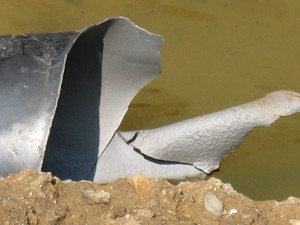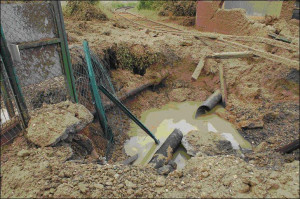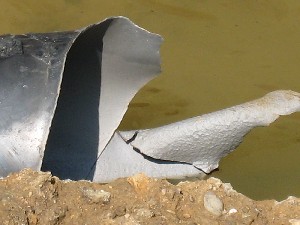Buried for 36 years at a depth of 2.5 m on a Seveso-rated plant involved in liquefying air on behalf of Lorraine’s regional industry, an oxygen (O2) pipeline pressurised at 40 bar burst at 1:45 pm along the property boundary, at the level where the pipeline crossed concrete channels underneath an onsite rail track. The internal emergency plan was activated, bringing fire-fighters and gendarme officers to the scene. At 2:30 pm, 26% of O2 was recorded at a distance of 5 m from the isolated pipe section. The operator informed the plant’s clients and at 6 pm issued a press release.
A freestanding O2 pipeline and another N2 pipeline also running through a concrete duct underneath the rail tracks were both adjacent to the damaged structure. In supplying the safety systems of several sites, the immediately adjacent N2 pipeline, which could have been damaged with the risk of bursting, could not be shut off without interrupting service to the clients’ installations.
The DREAL regional authority requested a safety perimeter be set up around the oxygen pipeline, in addition to dropping the N2 pressure and installing a surveillance camera. Under the aegis of “pipeline legislation”, a prefectural order confirmed these points and requested an expert metallurgical appraisal of the damaged tube as well as the geotechnical considerations surrounding this installation.
Welded in a spiral, made of E24-4 steel (thickness: 4.9/4.3 mm min. / max. service pressure: 44 bar), lined with coal tar pitch and featuring cathodic protection (- 1.4 V), the DN 300 oxygen pipeline was deployed in a 1-m strip immersed in water. A crater (diam.: 7 m, depth: 3 m) was formed, with sludge and pavement/concrete fragments being projected out to 50 m, with debris between 1 kg and 15 kg sprayed 60 m and 30 m, respectively. A nearby concrete wall was partially destroyed, and the fence sustained major damage. The TNT equivalent of the blast was evaluated at 0.14 kg. No fire outbreak was detected on the tube; however, a 220 / 24 V transformer ignited 3 or 4 m away. The pipeline lost its contents over a 13-km stretch, releasing 257 tonnes of O2 (or 180,000 m3). Damage was appraised at €1.05 million.
According to site recordings, no mechanical aggressions (due to works) or pressure surges had occurred. The classified facilities inspectorate received the accident report (including internal emergency plan) along with a technical file on the pipeline. The tubes sampled remained exposed for 2 months to the open air before being handed over to experts. In observing during August their widespread corrosion, the DREAL authority requested the tubes be placed inside.
Intermediate expert reports cited a flawed installation, soil/embankment quality, and poor quality of the substratum differential settlements, all due to the presence of the rail track. Such phenomena would have been perceptible at the surface, yet went unreported according to the expert, who forwarded the hypothesis of corrosion enhanced by extended immersion due to a fluctuating water table (Moselle River) at shallow depths (-2.2 m) and sulphur-reducing bacteria or chlorides explaining the craters on the outer tube surface. The investigation also revealed a replaced (thicker) pipeline section 5 m from the rupture and an unexpected oval shape at one end of the tube.
The final metallurgical expert’s report backed a combination of several factors: seal breach in the sleeve; lower water level in the sleeve, creating medium discontinuities for the electrolyte and less cathodic protection; local deterioration of the lining; debonding of the tar pitch. As water hit the tar pitch/steel interface, the onset of corrosion punctured the pipeline; then, an O2 micro leak accelerated the phenomenon.
The operator studied the generic or exceptional nature of the event that had occurred on the network. Pertinent feedback concerned:
- activation of the internal emergency plan (upper-tier Seveso rating) and not the fire safety plan, since the accident occurred within the plant boundary on a transport facility as opposed to a “plant pipe”; their boundaries were to be specified in dedicated safety studies, i.e.: degree of pipeline coverage in the internal plan;
- safety studies on installation techniques and local hydrogeology/geotechnical features to better grasp the “water table lowering” risk;
- distances associated with “sudden rupture” effects: crater, wall, projections. Beyond having to verify the “safety report” data furnished by the operator, the “ELS”, “PEL” and “IRE” designations defining zone exposure for such pipelines were also subject to review;
- in excluding third-party works or ground movements, corrosion cited as the event triggering this pipe break.
Download the detailed report in .pdf format (1.1 Mb)






